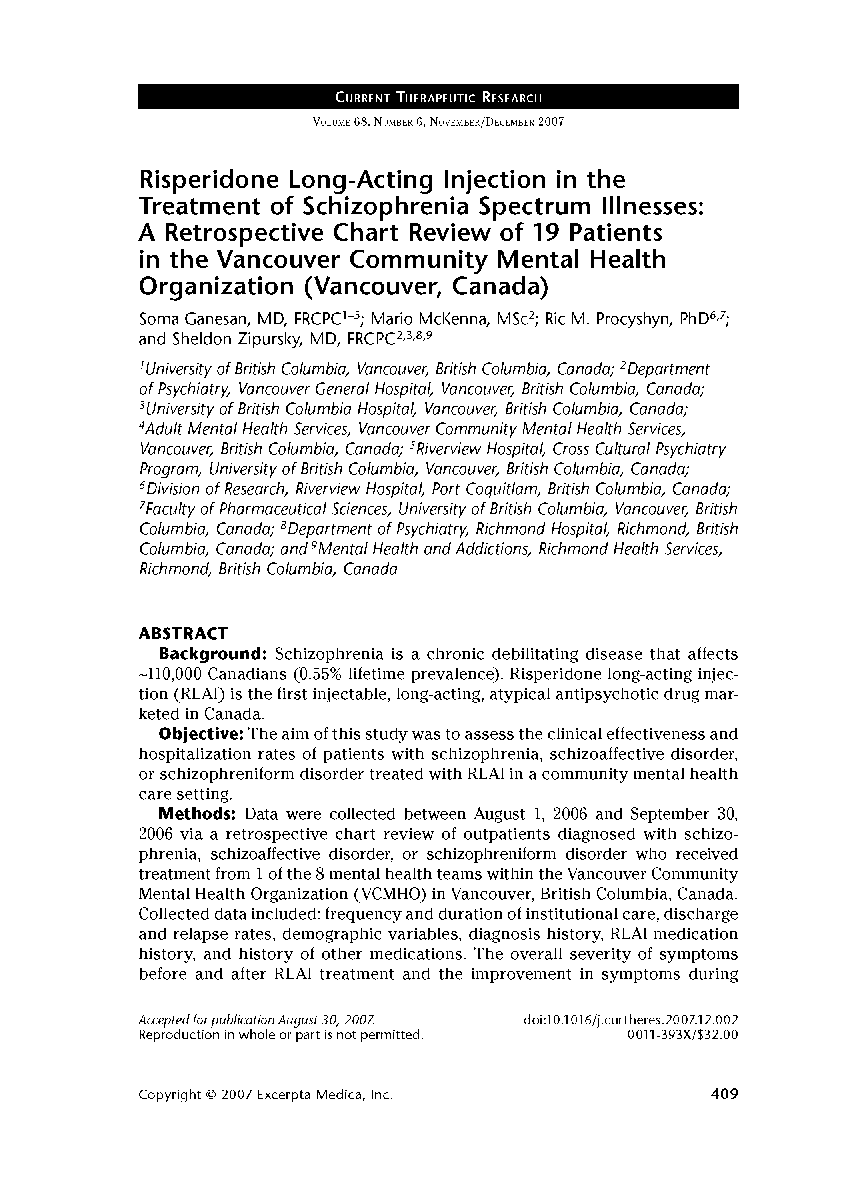| کد مقاله | کد نشریه | سال انتشار | مقاله انگلیسی | نسخه تمام متن |
|---|---|---|---|---|
| 4196993 | 1278733 | 2007 | 12 صفحه PDF | دانلود رایگان |

Background: Schizophrenia is a chronic debilitating disease that affects ~110,000 Canadians (0.55% lifetime prevalence). Risperidone long-acting injection (RLAI) is the first injectable, long-acting, atypical antipsychotic drug marketed in Canada.Objective: The aim of this study was to assess the clinical effectiveness and hospitalization rates of patients with schizophrenia, schizoaffective disorder, or schizophreniform disorder treated with RLAI in a community mental health care setting.Methods: Data were collected between August 1, 2006 and September 30, 2006 via a retrospective chart review of outpatients diagnosed with schizophrenia, schizoaffective disorder, or schizophreniform disorder who received treatment from 1 of the 8 mental health teams within the Vancouver Community Mental Health Organization (VCMHO) in Vancouver, British Columbia, Canada. Collected data included: frequency and duration of institutional care, discharge and relapse rates, demographic variables, diagnosis history, RLAI medication history, and history of other medications. The overall severity of symptoms before and after RLAI treatment and the improvement in symptoms during treatment were evaluated using the Clinical Global Impression Scales for severity (CGI-S)(1 = not ill to 7 = extremely ill) and improvement (CGI-I)(1 = very much improved to 7 = very much worse).Results: Forty-four patients were identified as having received RLAI. The charts of 19 patients (10 men, 9 women; mean [SD] age at time of chart audit, 36.7 [11.7] years; mean [SD] age at primary diagnosis, 23.6 [7.4] years; race: white, 10 [52.6%]; Asian, 6 [31.6%]; American Indian, 1 [5.3%]; black, 1 [5.3%]; other, 1 [5.3%]) were included in the analysis. The majority of patients (78%) had been treated with another antipsychotic drug prior to treatment with RLAI: risperidone (77%), quetiapine (47%), zuclopenthixol (43%), olanzapine (43%), and loxapine (17%). Mean (SD) CGI-S Scale score declined significantly from 5.29 (1.3) before treatment initiation to 3.05 (1.0) posttreatment (P < 0.001). Mean (SD) CGI-I Scale score was 2.58 (0.71) (P < 0.001); 94% of patients had a CGI-I score ≤3. Mean (SD) duration of hospitalization decreased significantly from 15.7 (19.7) days before treatment to 2.4 (6.0) days after treatment (P < 0.05). Mean (SD) number of hospializations also decreased significantly from 2.0 (1.8) before treatment to 0.5 (1.3) after treatment (P < 0.01).Conclusions: The results of this pilot study suggest that use of the atypical-antipsychotic medication RLAI significantly decreased duration and rates of hospitalization, compared with baseline, in these VCMHO patients with schizophrenia spectrum illnesses.
Journal: Current Therapeutic Research - Volume 68, Issue 6, November–December 2007, Pages 409-420